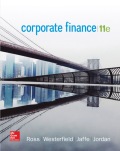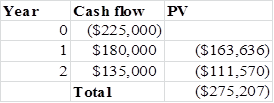
Concept explainers
Comparing Investment Criteria The treasurer of Amaro Canned Fruits, Inc., has projected the cash flows of Projects A, B, and C as follows:

Suppose the relevant discount rate is 12 percent per year.
- a. Compute the profitability index for each of the three projects.
- b. Compute the
NPV for each of the three projects. - c. Suppose these three projects are independent. Which project(s) should Amaro accept based on the profitability index rule?
- d. Suppose these three projects are mutually exclusive. Which project(s) should Amaro accept based on the profitability index rule?
- e. Suppose Amaro’s budget for these projects is $450,000. The projects are not divisible. Which project(s) should Amaro accept?
a)
To determine: The profitability index.
Profitability Index:
Profitability index shows whether a project is worth following or not by dividing net present value cash inflow from initial investment.
Explanation of Solution
Project A
Given,
PV of the entire cash inflow is $278,858.41.
Initial investment is $225,000.
Formula to calculate profitability index:
Substitute $278,858.41 for PV of the entire cash inflow and $225,000 for initial investment.
The profitability index is 1.23.
For Project B
Given,
PV of the entire cash inflow is $507,015.30.
Initial investment is $450,000.
Formula to calculate profitability index:
Substitute $507,015.30for PV of the entire cash inflow and $450,000 for initial investment.
The profitability index is 1.12.
For Project C
Given,
PV of the entire cash inflow is $275,206.61.
Initial investment is $225,000.
Formula to calculate profitability index:
Substitute $275,206.61 for PV of the entire cash inflow and $225,000 for initial investment.
The profitability index is 1.22.
Working notes:
Calculation for present value of Project A,
Calculation for present value of Project B,
Calculation for present value of Project C,

Hence, the profitability index of project A, B and C is 1.23, 1.12 and 1.22 respectively.
b)
To determine: The Net present value.
Net Present Value (NPV):
Net present value refers to the present value of all the future cash flow that is adjusted according to the time value of money.
Explanation of Solution
For Project A
Given,
PV of the entire cash inflow is $278,858.41.
Initial investment is $225,000.
Formula to calculate NPV:
Substitute $278,858.41for PV of the entire cash flow and $225,000 for initial investment.
The NPV of this project is $53,858.41.
For Project B
Given,
PV of the entire cash inflow is $507,015.30.
Initial investment is $450,000.
Formula to calculate NPV:
Substitute $507,015.30 for PV of the entire cash flow and $450,000 for initial investment.
The NPV of this project is $57,015.3.
For Project C
Given,
PV of the entire cash inflow is $275,206.61.
Initial investment is $225,000.
Formula to calculate NPV:
Substitute$275,206.61 for PV of the entire cash flow and $225,000 for initial investment.
The NPV of this project is $50,206.61.
Hence, the NPV of project A, B and C is$53,858.41, $57,015.3 and $275,206.61 respectively.
c)
To determine: Whether to choose project A or B or C on the basis of profitability index, if these projects are independent.
Answer to Problem 17QP
Solution:
Company AC should choose Project A first then Project C and at last Project B.
Explanation of Solution
Profitability index shows the dollar earned for the par dollar invested and higher the profitability index means higher the money he is earning on his investment. On the basis of this, Company AC should choose Project A first then Project C and at last Project B because the profitability index is highest for Project A and at second for Project C and at last for Project B.
Hence, Company AC should choose Project A first then Project C and at lastProject B.
d)
To determine: Whether to choose project A or B or C on the basis of profitability index, if the projects are mutually exclusive.
Answer to Problem 17QP
Solution:
A should choose Project A.
Explanation of Solution
Profitability index shows the dollar earned for the par dollar invested and higher the profitability index means higher the money he is earning on his investment. On the basis of this, A should choose Project A because project A has the highest profitability index of 1.23.
Hence, Company AC should choose Project A.
e)
To determine: Whether to choose project A or B or C, if total budget is $450,000.
Answer to Problem 17QP
Solution:
Company AC should choose Project A and Project C.
Explanation of Solution
Company AC should choose Project A and C because the total; NPV of Project A and C is $104,065.02 which is far above than the NPV of Project B which is $57,015.3.
Hence, Company AC should choose Project A and Project C.
Want to see more full solutions like this?
Chapter 5 Solutions
EBK CORPORATE FINANCE
- Select a real-world case situation. Use this case which you either know about already or have identifiedthrough research and address the following questions in essay format:.i. Outline and discuss what “triggered” the regulatory body to intervene? ii. How effective do you think the response was to such a crisis? iii. Outline and discuss two ways that could be used to strengthen the current regulatoryarrow_forwardle Shema actencial de theophile cautionarrow_forwardYou plan to purchase a $200,000 house using either a 30-year mortgage obtained from your local savings bank with a rate of 7.25 percent, or a 15-year mortgage with a rate of 6.50 percent. You will make a down payment of 20 percent of the purchase price. Calculate the amount of interest and, separately, principal paid on each mortgage. What is the difference in interest paid? Calculate your monthly payments on the two mortgages. What is the difference in the monthly payment on the two mortgages?arrow_forward
- Problem 2-21 Financial Statements Use the following information for Ingersoll, Incorporated. Assume the tax rate is 23 percent. 2020 2021 Sales Depreciation $ 19,073 $17,436 1,811 1,886 Cost of goods sold 4,729 4,857 Other expenses 1,021 899 Interest 870 1,001 Cash 6,292 6,916 Accounts receivable 8,190 9,877 Short-term notes payable 1,320 1,297 Long-term debt 20,770 25,011 Net fixed assets 51,218 54,723 Accounts payable 4,624 5,094 Inventory 14,538 15,438 1,700 1,768 Dividends Prepare a balance sheet for this company for 2020 and 2021. (Do not round intermediate calculations.) Cash Assets Accounts receivable Inventory INGERSOLL, INCORPORATED Balance Sheet as of December 31 2020 2021 $ 6,292 $ 6,916 8,190 9,877 14,538 15,438 Drov 14 of 20 Nearrow_forwardProblem 6-35 Financial Break-Even Analysis The technique for calculating a bid price can be extended to many other types of problems. Answer the following questions using the same technique as setting a bid price; that is, set the project NPV to zero and solve for the variable in question. Martin Enterprises needs someone to supply it with 152,000 cartons of machine screws per year to support its manufacturing needs over the next five years, and you've decided to bid on the contract. It will cost $1,920,000 to install the equipment necessary to start production; you'll depreciate this cost straight-line to zero over the project's life. You estimate that, in five years, this equipment can be salvaged for $162,000. Your fixed production costs will be $277,000 per year, and your variable production costs should be $10.60 per carton. You also need an initial investment in net working capital of $142,000. The tax rate is 22 percent and you require a return of 12 percent on your investment.…arrow_forwardYou plan to purchase a $100,000 house using a 30-year mortgage obtained from your local credit union. The mortgage rate offered to you is 8.25 percent. You will make a down payment of 20 percent of the purchase price. Calculate the amount of interest and, separately, principal paid in the 225th payment. Calculate the amount of interest paid over the life of this mortgage.arrow_forward
- What are the back ground of Sears problem, and what are the general of the problem statements? How to Create problem statements and applicable research questions? What are the lessons learned from Sears that business people or organization should avoid?arrow_forwardWhat are the research assumptions, and the research limitations, please give examples for each one, and explain how the limitation in the example might be mitigated? What are the research delimitations and give one example please. Hhow Biblical principles are related to reliability and validity.arrow_forwardWhat are the six sources of data collection and please help to explain the qualitative data collection methods. What is the thematic analysis? How to anticipated themes in a research proposal?arrow_forward
- Explain in detail the principle of Compounding of interest and why is it so important in Finance.arrow_forwardWhat is the bond quote for a $1,000 face value bond with an 8 percent coupon rate (paid semiannually) and a required return of 7.5 percent if the bond is 6.48574, 8.47148, 10.519, and 14.87875 years from maturity?arrow_forwardGentherm Incorporated has a convertible bond issue outstanding. Each bond, with a face value of $1,000, can be converted into common shares at a rate of 42.25 shares of stock per $1,000 face value bond (the conversion rate), or $19.85 per share. Gentherm’s common stock is trading (on the NYSE) at $19.85 per share and the bonds are trading at $1,025. Calculate the conversion value of each bond. Note: Round your answer to 4 decimal placesarrow_forward
 Essentials Of InvestmentsFinanceISBN:9781260013924Author:Bodie, Zvi, Kane, Alex, MARCUS, Alan J.Publisher:Mcgraw-hill Education,
Essentials Of InvestmentsFinanceISBN:9781260013924Author:Bodie, Zvi, Kane, Alex, MARCUS, Alan J.Publisher:Mcgraw-hill Education,

 Foundations Of FinanceFinanceISBN:9780134897264Author:KEOWN, Arthur J., Martin, John D., PETTY, J. WilliamPublisher:Pearson,
Foundations Of FinanceFinanceISBN:9780134897264Author:KEOWN, Arthur J., Martin, John D., PETTY, J. WilliamPublisher:Pearson, Fundamentals of Financial Management (MindTap Cou...FinanceISBN:9781337395250Author:Eugene F. Brigham, Joel F. HoustonPublisher:Cengage Learning
Fundamentals of Financial Management (MindTap Cou...FinanceISBN:9781337395250Author:Eugene F. Brigham, Joel F. HoustonPublisher:Cengage Learning Corporate Finance (The Mcgraw-hill/Irwin Series i...FinanceISBN:9780077861759Author:Stephen A. Ross Franco Modigliani Professor of Financial Economics Professor, Randolph W Westerfield Robert R. Dockson Deans Chair in Bus. Admin., Jeffrey Jaffe, Bradford D Jordan ProfessorPublisher:McGraw-Hill Education
Corporate Finance (The Mcgraw-hill/Irwin Series i...FinanceISBN:9780077861759Author:Stephen A. Ross Franco Modigliani Professor of Financial Economics Professor, Randolph W Westerfield Robert R. Dockson Deans Chair in Bus. Admin., Jeffrey Jaffe, Bradford D Jordan ProfessorPublisher:McGraw-Hill Education





